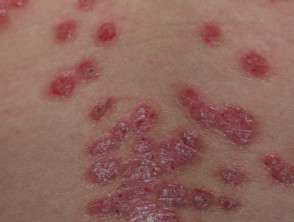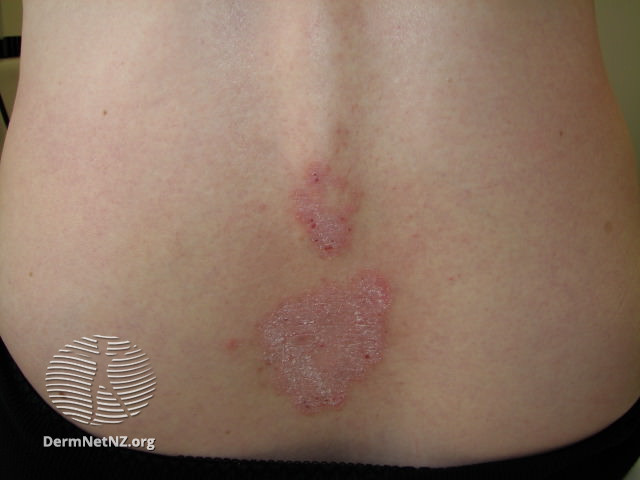Plaque psoriasis is the most common form of psoriasis. Plaque psoriasis is diagnosed in 80% of people with psoriasis.
The plaques appear as red, raised, inflamed lesions covered with a silvery white layer of flakey scales. They may vary in size from a 1/2 inch to 6 inches in diameter. Plaques may grow together, creating large affected areas.
may vary in size from a 1/2 inch to 6 inches in diameter. Plaques may grow together, creating large affected areas.
Plaques (as those shown in the images) occur most commonly on the scalp, knees, elbows, and lower back,
but they can appear anywhere on the body, including the genitals.
Fingernails and toenails may also be affected, causing pitted, whitened, and thickened nails.
Plaque psoriasis also has these characteristics:
- The plaques can vary in size and appear individually, in patches, or blanketed over large areas of the body.
- The plaques often appear first as small red bumps, accompanied by itching and a burning sensation. As the bumps get bigger, silvery scales form on top and the skin becomes raised and thickened.
- In addition to lesions, the skin usually becomes dry, itchy, and sometimes painful enough to interrupt day-to-day activities, especially if cracking and bleeding are present.
Treatment of Plaque Psoriasis
In general, mild psoriasis can usually be treated effectively with a variety of psoriasis treatments.
Topical medications are usually recommended as a first-line treatment for mild cases where there is limited area to be treated. Commonly prescribed topical medications include the following:
- Anthralin
- Coal tar
- Topical corticosteroids, particularly potent or superpotent formulations. These are the most commonly prescribed medication for psoriasis.
- Topical retinoids (Tazorac®)
- Vitamin D derivatives (Taclonex®, Vectical®)
Localized plaques on the hands or feet may not respond to topical medications and may be treated with laser light.
Moderate to severe psoriasis may require use of systemic treatments, such oral medications (methotrexate, cyclosporine), or biologics (Enbrel®, Humira®, Remicade®, Stelara®).
Phototherapy may also be recommended for widespread plaque psoriasis.
Many psoriasis medications may be used in combination. For instance, topical corticosteroids may be used in combination with vitamin D derivatives. Biologics may be used in combination with methotrexate or phototherapy.
Your doctor will prescribe a treatment plan based on several variables including the following:
- location of the psoriasis lesions (trunk vs. hands/feet vs. scalp)
- the severity of the flare
- your response to previous treatments
Image Source: DermNet NZ
Source: Vivacare
Last updated : 7/16/2021